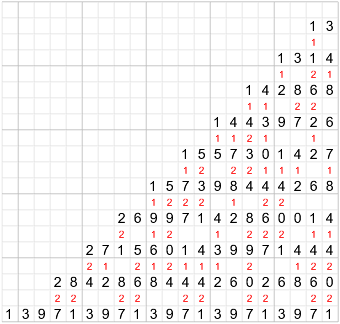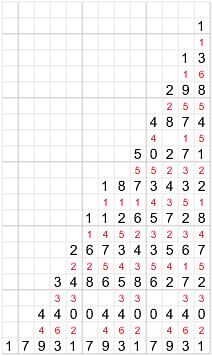Home
> urticator.net
Search
About This Site
> Domains
Glue
Stories
Computers
Driving
Games
Humor
Law
Math
> Numbers
Science
> Powers and Fractions
Notes About Squares
Decimal Expansions (Section)
Number Maze
Primes
Divisibility
Intrinsic Nature of Primes
Other Topics
Other Topics (2)
Powers of 2
Powers of 2 and 3
|
> Powers of N |
Fractions in Base 2
Fractions in Base N
Powers of N
What I want to do here is describe a method I invented for computing lots of powers of a number N. “Invented” is a bit strong, maybe, but it's just a nice Latin way of saying “came up with” … anyway, what happened was, I wanted to compute a bunch of powers of two, and, being aware that the last digit repeats, I thought, well, I'll just take care of that first. That was back when I was in high school, but I'm sure that's exactly how it happened.I've already said enough about the powers of two, so to demonstrate how the method works, let's compute some powers of three (even though I've already said a bit about them too).
So, how do you compute powers of three? Well, you start with 30 = 1, and keep multiplying by 3, right? What else can you do? So … 1 × 3 = 3, and 3 × 3 = 9, and then we can do something a little different. Instead of just saying 9 × 3 = 27, let's write out the calculation in all its glory.
That becomes less pointless in the next step,
and then as the numbers get larger and larger, becomes quite … pointful? Pointy?
Now, if we take all those calculations and throw away everything but the last digits and the carries from the last digits, we get something that looks like this.
That's how we compute just the last digits. But, then, using the last-digit carries, we can compute all the next-to-last digits and the next-to-last-digit carries.
You probably can't tell just by looking at the results, but if you actually work out some digits for yourself, you'll see that the process is quite simple and fast. Here's a diagram that shows how it works.
All you have to do is take B, multiply by N (the number you're computing powers of), and add C, and then write the answer in D and E.
Since the same last-digit carries appear in both figures above, we ought to write one above the other to avoid copying. So, the calculation naturally grows upward rather than downward; and if we keep at it until we run out of carries, it grows up into a nice little triangle of numbers.
And there you have it, the powers of three all the way up to 320—just read down the columns and pick out the black digits. I particularly like 531441, which is 312.
If that was all there was to the method, I wouldn't have bothered to write about it, but there's a punchline, too: the red rows are the powers of 1/10 in base N! For example … the first carries repeat with length 4, so 1/10 in base 3 is 0.0022; and the second carries repeat with length 20, as you can just see from the zero at the end, so we have
1/100 = 0.00002102121110200122.
I'm sure I would never have noticed this, except that, as it happened, at about the same time as I was computing powers of two, I was also thinking about fractions in base 2. That was lucky!
Just for fun, here are the results for powers of seven.
I think my favorite one of these is 823543.
Interestingly, the expansion of 1/100 (0.0033) is just as short as the expansion of 1/10 (0.0462) … and there's actually a good reason for that, which is that 74−1 = 2400. If that makes no sense to you, see Fractions in Base N; you might also like to look at the footnote I wrote.
There are a couple of variants of the method that are worth mentioning. First, if you want to compute powers of N for N > 10, you can, but be warned that the carries won't be single digits. They can be as large as N−1 … which is exactly what you'd expect, since they're digits in base N. Second, if you want to compute expansions of 1/n for some n other than 10, you can do that, too … all you have to do is work in base n.
So … that's everything I have to say about the method I invented. But, I do have another purpose here, which is to tell you about all the nice powers of N that I'm familiar with. So, to that end, here are the first few powers of five.
0 1 1 5 2 25 3 125 4 625 5 3 125 6 15 625 7 78 125 8 390 625 9 1953 125
These are nice because of how the last three digits settle down. Also, as a result of that, you can work out the series of numbers that are formed by the remaining digits by multiplying by five at every step and adding three at every other step.
Finally, here are the first few powers of 11.
0 1 1 11 2 121 3 1331 4 14641
Obviously, these are nice because they look like the rows of Pascal's triangle. For an unusual perspective on why that is, check out what I said about polynomials at the end of Fractions in Base 2.
So, that's everything I know about powers of N. Putting the pieces together, you can see that I know something about every value of N up to N = 12 … 2, 4, and 8 are covered by the powers of two; 3, 6, 9, and 12 are covered by the powers of two and three; and of course I talked about 5, 7, and 11 right here. Beyond that, I recognize the squares up to around N = 27, but then that's really the end.
See Also
Exceptions Explained, The
History and Other Stuff
Logarithmic Forms
Multiplication in Base 10
Multiplication in Base 7
Nagell-Ljunggren Equation, The
Numbers as Polynomials
Partitions
Powers of 2
Primes
Squares
Twelve-Note Scale, The
Usual Random Thoughts, The
o March (2004)
@ April (2004)
July (2005)






